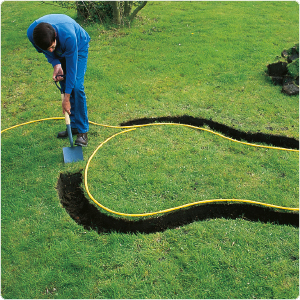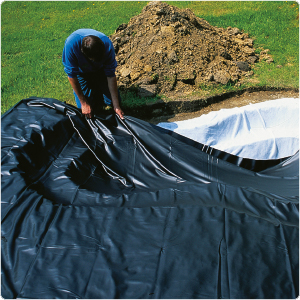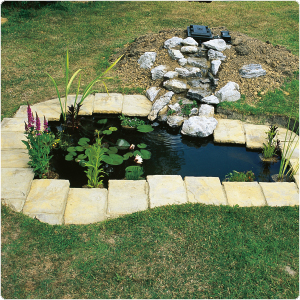Installing a pond liner
For those preferring a more unique design albeit with a little more work, flexible pond liners are available to suit a variety of styles and budgets. Check out the steps below to learn how to install a pond liner as well as how to work out how much liner your pond needs.
1. Marking out

Once you have marked out the desired shape with rope, sand or hosepipe, dig around the design, making a 15cm deep collar, one spade width wide.
Dry concrete mix can then be placed in the trench. Spray with water, and allow the concrete collar to set overnight.
2. Adding shelving

Once the concrete has set, start digging the marginal shelving. It is advisable to buy plant baskets first to ensure they fit the shelving. Allow 5cm extra depth above the basket depth to allow for a top level of gravel around the plants’ base.
3. Work out how much liner and underlay you need
Once dug, the hole can be measured up for the liner. Underlay is essential to protect the liner from potential leaks in your pond.
To get an accurate measurement of the pond liner required, you will need to know the pond’s dimensions: its length, width, and maximum depth. Use the equation below to calculate underlay and liner size.
- Measure Length and Width: Begin by measuring the length and width of your pond. Take note of the maximum depth you plan for the pond. If your pond has curved edges, estimate the average width to simplify calculations.
- Apply the Formula: The formula for working out how much pond the pond liner you need is as follows:
- Liner Width: Width + (Maximum Depth x 2)
- Liner Length: Length + (Maximum Depth x 2)
Add Overlap for Safety: To ensure you have enough liner to securely anchor it, add an additional 30cm to both the calculated width and length.
4. Laying out liner

Having checked for, and removed, any stones or sharp objects, lay the underlay in the pond and place the folded liner on top.
Carefully open the liner up and lay it on top of the underlay. Ensure there is ample liner around the edge of the pond on which coping stones, decking etc can be positioned. When laying the liner it is advisable to remove shoes to prevent damaging the liner.
5. Finishing touches

Once the liner has been installed, any paving or rockwork can be added to the surrounding area. If a rockery and waterfall is desired, remember to save the soil from the excavation.
Should you double up the pond liner?
If you’re looking for added protection against punctures and wear, doubling up the pond liner can be a good option. This approach involves placing two liners in the pond, one on top of the other, which can create a more resilient barrier against sharp objects or roots that might penetrate the liner over time.
How many years does a pond liner last?
A good pond liner from rubber or EPDM (Ethylene Propylene Diene Monomer) can last 20 to 30 years if properly maintained and installed. These materials are known for their excellent durability and resistance to UV rays, extreme temperatures, and punctures.
We recommend checking your liner for leaks every so often, especially after the winter months or after extreme weather.
